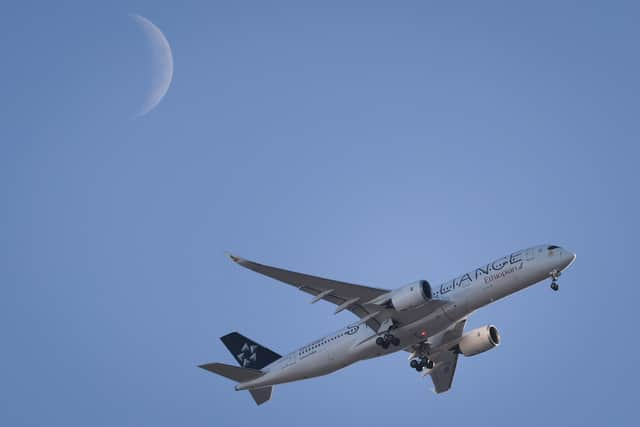10 air travel myths debunked - is the brace position actually safe and do planes dump waste mid-air?
and live on Freeview channel 276
A leading travel tour operator has debunked the top 10 most common myths about air travel from the concern about recirculated air in planes contributing to the spread of disease to planes dumping human waste mid-flight. To clear up concerns about flights, Ski Vertigo sets the record straight on some of the most widespread misconceptions about air travel.
A spokesperson said air travel is “surrounded by a myriad of myths that can cause unnecessary concern for travellers” and “understanding the reality behind these myths is key to a more relaxed and informed flying experience.”
Advertisement
Hide AdAdvertisement
Hide AdOne of the myths that the tour operator debunks is a concern many have that the brace position is used to kill passengers for insurance purposes. The spokesperson adds that “every flight is a collaboration between highly trained professionals, both on the ground and in the air, working tirelessly to ensure your safety” and advises passengers to “sit back” and “relax” on their next journey.
Listed are the top 10 most common myths - and why the tour travel operator has debunked them.


The top 10 most common aeroplane myths
The brace position is used to kill passengers for insurance purposes
Ski Vertigo says this myth is entirely false and baseless as the brace position is a well-established safety protocol, recommended by aviation experts to protect passengers in the event of an impact. It adds that the brace position is designed to minimise injury by aligning and shielding the head, neck, and spine, reducing movement during a crash.
Planes dump human waste mid-air
The tour travel operator says planes do not dump human waste in-flight as modern aircraft are equipped with waste storage tanks that are only emptied once the plane has landed. It adds that the Federal Aviation Administration (FAA) has made it clear that it's physically impossible for pilots to release these tanks during flight, ensuring environmental responsibility and compliance with strict regulations.
Advertisement
Hide AdAdvertisement
Hide AdRecirculated air in planes spreads disease
Ski Vertigo says the concern about recirculated air in planes contributing to the spread of disease is largely unfounded as aircraft utilise advanced air filtration systems, similar to those found in hospitals, capturing between 94 and 99.9% of airborne microbes. It adds that the cabin air is also refreshed every few minutes, often making it cleaner than the air found in many other indoor environments.
Oxygen masks on planes are decoys
The tour operator says oxygen masks in airplanes are a critical safety feature as they provide vital oxygen to passengers, allowing the aircraft to descend to a safer, breathable altitude. It adds that dismissing them as decoys is not only incorrect but potentially dangerous.
Survival chances in a plane crash are minimal
Despite common fears, the survival rate in plane crashes is remarkably high, according to Ski Vertigo. It says that the National Transportation Safety Board's data indicates that 95% of passengers involved in accidents on U.S. carriers from 1983 to 2000 survived and this high survival rate is a testament to the stringent safety standards and resilient designs of modern aircraft.
Lightning strikes will take down planes
The operator says planes are meticulously engineered to withstand lightning strikes. The aircraft's outer structure, typically made of aluminium, safely conducts the electrical charge without harming the integrity of the plane, the travel operator adds.
Advertisement
Hide AdAdvertisement
Hide AdPilots avoid flying over the Bermuda Triangle
The Bermuda Triangle, a region in the western part of the North Atlantic Ocean, is famous for its myths about mysterious disappearances of ships and aircraft. However, Ski Vertigo says the idea that pilots actively avoid flying over this area is a myth. It adds that the Bermuda Triangle is a heavily travelled route for both commercial and private flights, and there is no evidence to suggest that it is more dangerous than any other part of the ocean.
Flying at night is safer than daytime
Ski Vertigo says this concept is not supported by any significant evidence as the safety of a flight depends on numerous factors, including weather conditions, aircraft maintenance, and pilot training, rather than the time of day. It adds that both day and night flights are subject to the same rigorous safety standards and protocols, ensuring passenger safety regardless of the time.
You can open a plane door mid-flight
The travel tour operator says it is virtually impossible to open a plane door mid-flight at high altitudes. The significant difference in air pressure between the inside and outside of the cabin at cruising altitude, typically above 10,000 feet, makes it physically unfeasible to open the door, it adds.
Pilots and co-pilots eat the same meal
According to Ski Vertigo pilots and co-pilots often eat different meals as a precautionary measure against food poisoning. By consuming different meals, the risk of both pilots becoming ill simultaneously is significantly reduced, ensuring that at least one pilot is always in good health to fly the plane.
Comment Guidelines
National World encourages reader discussion on our stories. User feedback, insights and back-and-forth exchanges add a rich layer of context to reporting. Please review our Community Guidelines before commenting.
